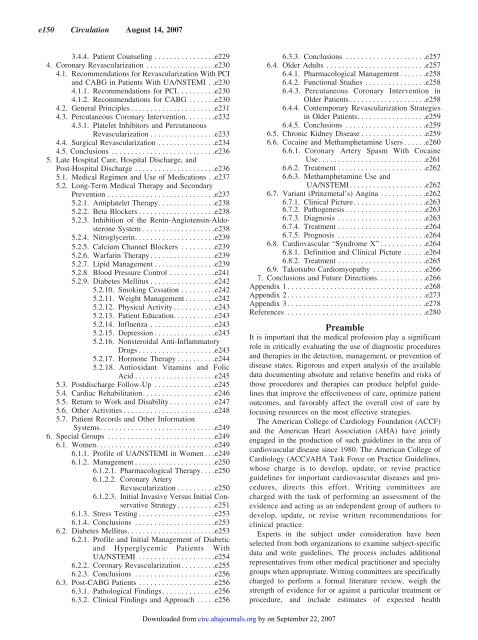ACC/AHA 2007 guideline update for the
ACC/AHA 2007 guideline update for the
ACC/AHA 2007 guideline update for the
You also want an ePaper? Increase the reach of your titles
YUMPU automatically turns print PDFs into web optimized ePapers that Google loves.
e150 Circulation August 14, <strong>2007</strong><br />
3.4.4. Patient Counseling ................e229<br />
4. Coronary Revascularization ..................e230<br />
4.1. Recommendations <strong>for</strong> Revascularization With PCI<br />
and CABG in Patients With UA/NSTEMI . .e230<br />
4.1.1. Recommendations <strong>for</strong> PCI. .........e230<br />
4.1.2. Recommendations <strong>for</strong> CABG .......e230<br />
4.2. General Principles ......................e231<br />
4.3. Percutaneous Coronary Intervention. .......e232<br />
4.3.1. Platelet Inhibitors and Percutaneous<br />
Revascularization .................e233<br />
4.4. Surgical Revascularization ...............e234<br />
4.5. Conclusions ...........................e236<br />
5. Late Hospital Care, Hospital Discharge, and<br />
Post-Hospital Discharge .....................e236<br />
5.1. Medical Regimen and Use of Medications . .e237<br />
5.2. Long-Term Medical Therapy and Secondary<br />
Prevention ............................e237<br />
5.2.1. Antiplatelet Therapy. ..............e238<br />
5.2.2. Beta Blockers ....................e238<br />
5.2.3. Inhibition of <strong>the</strong> Renin-Angiotensin-Aldosterone<br />
System ...................e238<br />
5.2.4. Nitroglycerin. ....................e239<br />
5.2.5. Calcium Channel Blockers .........e239<br />
5.2.6. Warfarin Therapy .................e239<br />
5.2.7. Lipid Management ................e239<br />
5.2.8. Blood Pressure Control ............e241<br />
5.2.9. Diabetes Mellitus .................e242<br />
5.2.10. Smoking Cessation .........e242<br />
5.2.11. Weight Management ........e242<br />
5.2.12. Physical Activity ...........e243<br />
5.2.13. Patient Education. ..........e243<br />
5.2.14. Influenza .................e243<br />
5.2.15. Depression ................e243<br />
5.2.16. Nonsteroidal Anti-Inflammatory<br />
Drugs ....................e243<br />
5.2.17. Hormone Therapy ..........e244<br />
5.2.18. Antioxidant Vitamins and Folic<br />
Acid .....................e245<br />
5.3. Postdischarge Follow-Up ................e245<br />
5.4. Cardiac Rehabilitation. ..................e246<br />
5.5. Return to Work and Disability ............e247<br />
5.6. O<strong>the</strong>r Activities ........................e248<br />
5.7. Patient Records and O<strong>the</strong>r In<strong>for</strong>mation<br />
Systems. .............................e249<br />
6. Special Groups ............................e249<br />
6.1. Women. ..............................e249<br />
6.1.1. Profile of UA/NSTEMI in Women . . .e249<br />
6.1.2. Management .....................e250<br />
6.1.2.1. Pharmacological Therapy. . . .e250<br />
6.1.2.2. Coronary Artery<br />
Revascularization ..........e250<br />
6.1.2.3. Initial Invasive Versus Initial Conservative<br />
Strategy ..........e251<br />
6.1.3. Stress Testing ....................e253<br />
6.1.4. Conclusions .....................e253<br />
6.2. Diabetes Mellitus. ......................e253<br />
6.2.1. Profile and Initial Management of Diabetic<br />
and Hyperglycemic Patients With<br />
UA/NSTEMI ....................e254<br />
6.2.2. Coronary Revascularization .........e255<br />
6.2.3. Conclusions .....................e256<br />
6.3. Post-CABG Patients ....................e256<br />
6.3.1. Pathological Findings. .............e256<br />
6.3.2. Clinical Findings and Approach .....e256<br />
Downloaded from<br />
circ.ahajournals.org by on September 22, <strong>2007</strong><br />
6.3.3. Conclusions .....................e257<br />
6.4. Older Adults ..........................e257<br />
6.4.1. Pharmacological Management .......e258<br />
6.4.2. Functional Studies ................e258<br />
6.4.3. Percutaneous Coronary Intervention in<br />
Older Patients ....................e258<br />
6.4.4. Contemporary Revascularization Strategies<br />
in Older Patients. .................e259<br />
6.4.5. Conclusions .....................e259<br />
6.5. Chronic Kidney Disease .................e259<br />
6.6. Cocaine and Methamphetamine Users ......e260<br />
6.6.1. Coronary Artery Spasm With Cocaine<br />
Use............................e261<br />
6.6.2. Treatment .......................e262<br />
6.6.3. Methamphetamine Use and<br />
UA/NSTEMI ....................e262<br />
6.7. Variant (Prinzmetal’s) Angina ............e262<br />
6.7.1. Clinical Picture. ..................e263<br />
6.7.2. Pathogenesis .....................e263<br />
6.7.3. Diagnosis .......................e263<br />
6.7.4. Treatment .......................e264<br />
6.7.5. Prognosis .......................e264<br />
6.8. Cardiovascular “Syndrome X” ............e264<br />
6.8.1. Definition and Clinical Picture ......e264<br />
6.8.2. Treatment .......................e265<br />
6.9. Takotsubo Cardiomyopathy ..............e266<br />
7. Conclusions and Future Directions. ............e266<br />
Appendix 1 ....................................e268<br />
Appendix 2 ....................................e273<br />
Appendix 3 ....................................e278<br />
References ....................................e280<br />
Preamble<br />
It is important that <strong>the</strong> medical profession play a significant<br />
role in critically evaluating <strong>the</strong> use of diagnostic procedures<br />
and <strong>the</strong>rapies in <strong>the</strong> detection, management, or prevention of<br />
disease states. Rigorous and expert analysis of <strong>the</strong> available<br />
data documenting absolute and relative benefits and risks of<br />
those procedures and <strong>the</strong>rapies can produce helpful <strong>guideline</strong>s<br />
that improve <strong>the</strong> effectiveness of care, optimize patient<br />
outcomes, and favorably affect <strong>the</strong> overall cost of care by<br />
focusing resources on <strong>the</strong> most effective strategies.<br />
The American College of Cardiology Foundation (<strong>ACC</strong>F)<br />
and <strong>the</strong> American Heart Association (<strong>AHA</strong>) have jointly<br />
engaged in <strong>the</strong> production of such <strong>guideline</strong>s in <strong>the</strong> area of<br />
cardiovascular disease since 1980. The American College of<br />
Cardiology (<strong>ACC</strong>)/<strong>AHA</strong> Task Force on Practice Guidelines,<br />
whose charge is to develop, <strong>update</strong>, or revise practice<br />
<strong>guideline</strong>s <strong>for</strong> important cardiovascular diseases and procedures,<br />
directs this ef<strong>for</strong>t. Writing committees are<br />
charged with <strong>the</strong> task of per<strong>for</strong>ming an assessment of <strong>the</strong><br />
evidence and acting as an independent group of authors to<br />
develop, <strong>update</strong>, or revise written recommendations <strong>for</strong><br />
clinical practice.<br />
Experts in <strong>the</strong> subject under consideration have been<br />
selected from both organizations to examine subject-specific<br />
data and write <strong>guideline</strong>s. The process includes additional<br />
representatives from o<strong>the</strong>r medical practitioner and specialty<br />
groups when appropriate. Writing committees are specifically<br />
charged to per<strong>for</strong>m a <strong>for</strong>mal literature review, weigh <strong>the</strong><br />
strength of evidence <strong>for</strong> or against a particular treatment or<br />
procedure, and include estimates of expected health
















